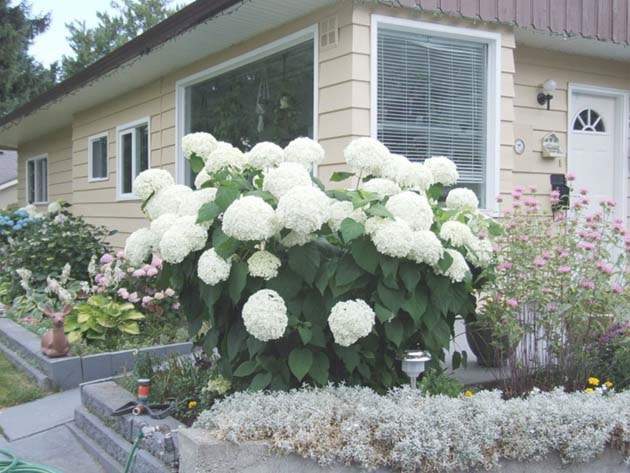 By type, I mean species.
By type, I mean species.
The genus Hydrangea includes more than 70 species, several of which will grow in Okanagan gardens.
There are actually only three common ones and a fourth if you include Hydrangea petiolaris, the climbing hydrangea, which by the way only needs pruning to control where it’s going for size and shape.
The three main species are H macrophylla big leaf hydrangea, H arborescens smooth hydrangea and H paniculata the panicled hydrangea.
Examples of not so common species are H sargentiana sargents hydrangea and H quercifola oak leafed hydrangea.
Although these two are not so common, they do make desirable specimen plants in Okanagan gardens.
Pruning practices for the different species vary.
Let’s take the H arborescens first; these include the very popular ‘Annabelle’ and newer varieties such as ‘Incrediball’ and ‘Invincibelle.’
All varieties have large ball-shaped blossom heads opening at first with a green colour, usually turning white to cream then drying to bronze as the season comes to an end.
These are best pruned first thing in spring before they leaf out.
They can be pruned hard to six inches from the ground or left a bit higher if they are in a sunny location.
You want to avoid too tall or the plant will be spindly especially in the shade.
Because the bloom heads are so large and dense they become very heavy in wet weather and will droop to the ground if the stems aren’t strong enough to hold them.
 The H paniculata sports conical shaped blossoms with several new and exciting varieties available.
The H paniculata sports conical shaped blossoms with several new and exciting varieties available.
Varieties to look for are ‘Unique’ ‘Fire Light’ ‘Pinky Winky’ and ‘Quick Fire’; these are all exciting varieties and all are very hardy and reliable bloomers.
This group can be pruned in spring to about the two-foot level and at the same time very old wood can be removed to promote renewal. All are very good for drying to make beautiful dried arrangements for indoor use.
The type of hydrangea that really put on a rare spectacular showing this year is the H macrophylla with its gorgeous blues and pinks.
I say rare because usually these can be quite sporadic with their performance often due to a cold winter freezing the bloom buds or incorrect pruning techniques.
Prune this group after the current seasons blossoms have finished and beginning to dry up.
Don’t prune hard as they bloom on old wood and you need to preserve the fat looking bloom buds.
If in doubt its best to leave these alone to avoid taking out the blooming wood.
There you have it a short lesson on how to prune you hydrangea.
Just a note on the blue and pink macrophylla: To keep that nice deep colour in the blue varieties apply aluminum sulphate in spring and re-apply in June.
The pinks have no problem staying a deep pink with our alkaline conditions in the Okanagan.
